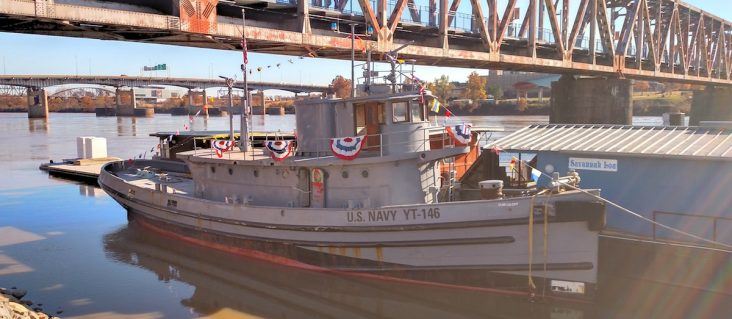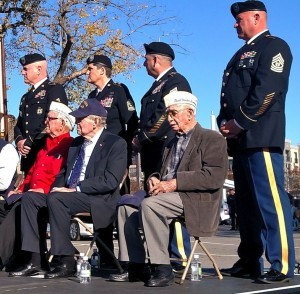Pearl Harbor remembrance noted in North Little Rock with unique ‘bookend’ of WWII
by December 7, 2015 10:43 pm 555 views

The USS Hoga (YT-146) is docked in her new home on the North Little Rock shore of the Arkansas River.
Three Arkansas veterans who were present 74 years ago when Japanese planes bombed Pearl Harbor were honored at an event at the North Little Rock-based Arkansas Inland Maritime Museum commemorating Pearl Harbor Day.
A few feet behind W.M. Chase, Walter Smith and Kay Matthews, the USS Hoga (YT-146) was docked in her new home on the North Little Rock shore of the Arkansas River. The tugboat was also at Pearl Harbor that day and is known for her heroic service to keep the harbor entrance open by pushing the sinking USS Nevada out of the entrance. That move kept the strategic military location in service during World War II, and by some estimates, potentially shortened the war by nearly a year.
Officials have been working for 10 years to get the Hoga to North Little Rock. Her arrival makes the museum the only location outside of Hawaii to have vessels on display that bookend the U.S. involvement in World War II. Hoga, at Pearl Harbor and the USS Razorback, one of two submarines in the Bay of Tokyo during the Japanese surrender.
The Hoga – a Native American word for “fish” – was transferred from Pearl Harbor to the Port of Oakland after World War II. It was declared a National Landmark in 1989. For many years after it was decommissioned, the Navy struggled to figure out what to do with it. In 2005, then Mayor Pat Hayes and the North Little Rock City Council won a bid to have it moved to central Arkansas with plans to open the maritime museum.

Arkansas Secretary of State Mark Martin, Arkansas First Lady Susan Hutchinson, North Little Rock Mayor Joe Smith, former U.S. Rep. Vic Snyder and former North Little Rock Mayor Hayes spoke during the event. Snyder and Hayes were still in office when plans to acquire the Hoga began. The two worked together to begin work on what is now the Arkansas Inland Maritime Museum.
Veterans Chase, Smith and Matthews were presented with commemorative coins by Secretary Martin.
“It is imperative that this generation and other to follow know what happened on December 7, 1941,” Martin said. “Pearl Harbor is a somber historical marker for us as Americans. We memorialize those who were lost. We thank God for those who survived.”
On the “Day which will live in infamy,” hundreds of Japanese fighter planes launched from aircraft carriers surprised American forces at the naval base at Pearl Harbor near Honolulu, Hawaii. The attack lasted two hours, and almost decimated the country’s Pacific naval forces. The Japanese destroy almost 20 significant American naval vessels, including eight powerful battleships. More than 300 airplanes, were destroyed, which at the time was a sizeable part of the country’s air forces in the theater. More than almost 2,500 Americans sailors and soldiers died, and at least 1,000 were wounded. Key infrastructure like dry docks and airfields at the base were also destroyed.
President Franklin D. Roosevelt asked Congress to declare war on Japan the next day, and Congress approved his declaration with just one dissenting vote.
